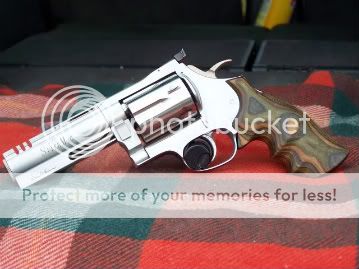Supporter
Range Officer

Range Officers
May 2, 2009
 Offline
OfflineRange Officer

Range Officers

Dans Club
February 9, 2009
 Offline
OfflineRange Officer

Range Officers

Dans Club
February 9, 2009
 Offline
OfflineSupporter
Range Officer

Range Officers
May 2, 2009
 Offline
OfflineNovember 4, 2008
 Offline
OfflineGuys, I don't want to pick a nit here but;
there are some bullseye shooters out there that have used the Smith & Wesson Model 52 for years. They will tell you that .38 +P brass should be avoided when loading the 148 gr. WC because the brass on the +P is thicker at the base and tapers thinner as it reachs the top.
This in turn will create a tendency for the WC to bulge the case when seated flush with the top which is required with the 52 auto loader.
Regular .38 brass is not tapered from thick to thinner.
Supporter
Range Officer

Range Officers
May 2, 2009
 Offline
OfflineNovember 4, 2008
 Offline
OfflineShoot,
Out of curiosity, I googled "difference in .38 special regular brass and +P" and found a number of threads on it. It appears that Starline produces .38 and .38+P to the same dimensions. However their .45 ACP+P is strengthed.
It appears that it is up to the manufacturer and the era the brass was manufactured in for the rest.
Probably not worth the effort to cut a perfectly good couple of shells over but WTH, maybe you could complete the experiment with a different brand and let us know what you do find.


DWF Supporters

Dans Club

Moderators
November 17, 2008
 Offline
OfflineInteresting, however this only gos to show if you strive to eliminate all variables you should use one brand/lot of brass. I mix my 38s as I only plink with 38s and it just isn't that big of a deal. Back in my silhouette days I used like lots of brass for competition.

LB
Wisdom is merely the realization of how little one knows, therefore I am wise.
Supporter
Range Officer

Range Officers
May 2, 2009
 Offline
Offline
DWF Supporters

Dans Club

Moderators
November 17, 2008
 Offline
OfflineDon't mean to swipe a thread but as for 223 brass, yes military ammo is different than civilian and should not be mixed. At least for the 223. Yes it fits and will shoot, but is considered unsafe. The internal dimension of military brass (.556) is smaller causing a pressure increase. It also has to do with the lead space in the chamber of mil-spec rifles. If your firearm is marked 223 shoot only 223ammo. If it's marked .556 or NATO, it is fine to shoot either commercial 223 or military ammo. When handloading one must adjust for the different thickness in the brass, not to mention reaming primer pockets is a pain.
LB
Wisdom is merely the realization of how little one knows, therefore I am wise.
Range Officer

Range Officers

Dans Club
February 9, 2009
 Offline
OfflineSince the topic is officially stolen, Jaggman is involved anyway and he started it  . I have learned alot about .223 loading with military brass for AR-15's. Most of what I learned is that I don't like it very much. I hate seating the primers. I have loaded rounds that will work though. Any military loading wisdom to be imprted would be appreciated.
. I have learned alot about .223 loading with military brass for AR-15's. Most of what I learned is that I don't like it very much. I hate seating the primers. I have loaded rounds that will work though. Any military loading wisdom to be imprted would be appreciated.
A man cannot have too many SuperMags
January 22, 2008
 Offline
OfflineI have compared the weight difference of 38S and 38S+P brass from the same manufacturer and found the +p stuff the be a little bit heaver. This was a while ago and I don't recall the weight difference. IIRC the two manufactures I checked were Remington and Winchester.
RCBS makes a primer pocket swaging tool that will remove the crimp on military brass. I made the mistake of buying 3000 rounds of once fired Lake City (military) .223 brass. The RCBS tool adds one step to the brass preparation process but makes the job of pressing in new primers so much easier.
-Wayne

1 Guest(s)

 Register
Register Log In
Log In Home
Home






